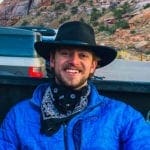|
Getting your Trinity Audio player ready...
|
Established in 1964
In the vast, rugged wilderness of the Colorado Plateau, you’ll find dramatic desert landscapes and blissful solitude, carved out by the Colorado and Green rivers. Canyonlands National Park is everything intriguing about this harsh and foreboding landscape of the American Southwest.
Utah is known far and wide for The Mighty Five; its unique, wild, and picturesque National Parks. Each has its own character and color, and they are easily some of the most inspiring works of art that the delicate hand of nature ever carved out. Of these, Canyonlands National Park is by far the most overlooked.
Despite its colossal size (it’s the largest in the state, roughly the size of the Faroe Islands, it receives just a small fraction of the visitation that the Utah’s other national parks do. And of the visitors that do make the trek to this remote and inaccessible fortress of stone, as many as three quarters of them see less than a third of the park. The most difficult corner to access, The Maze District, sees only 1.4% of the park’s total visitors.
Canyonlands is everything intriguing about the harsh and foreboding landscape of the Southwest. A rugged, untamed mass of canyons and ridges, with pockets so remote that they are completely untouched by human kind. It was the muse of Edward Abbey, famous nature writer, who called it “the most weird, wonderful, magical place on earth”. It’s not the kind of place you could see in a day, or a year, or even a lifetime, but don’t let that deter you from trying. The vastness of Canyonlands is full of odd nooks and crannies – secret places that few have ventured to look on. If you have the spirit of adventure in you, you’ll find yourself right at home here.
For that reason, Canyonlands is the kind of place that requires some explanation. So we decided to create a guide for the newcomer: detailing the park’s story, the things you may find while there, and a few ways to explore it. Whether you’re already looking to go, or have never heard of Canyonlands, start here. If you’re anything like the many who return every year, you may just find yourself enchanted for life.
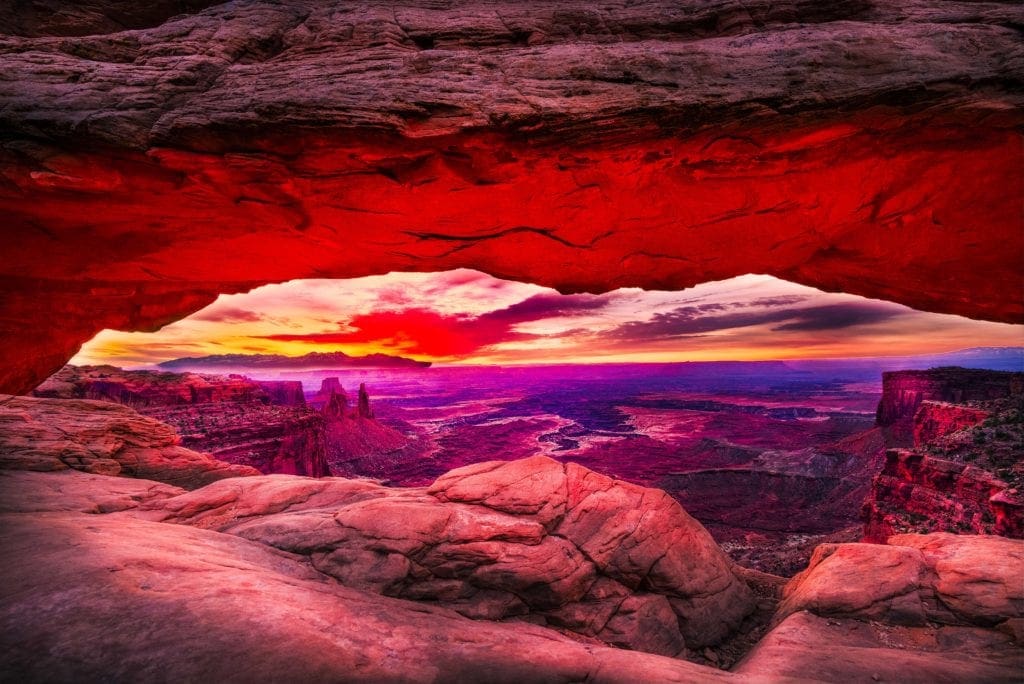
Pre-dawn view of iconic Mesa Arch in Canyonlands National Park, Utah
Human History
The human history of Canyonlands goes back long before written history began. Various family groups of nomadic peoples ranged through the southwest for thousands of years after the last ice age, coming and going with the seasons. As people became more sedentary, cultural lines grew more obvious. The two main prehistoric cultures native to the Southwest were the Fremont and Ancestral Puebloans.
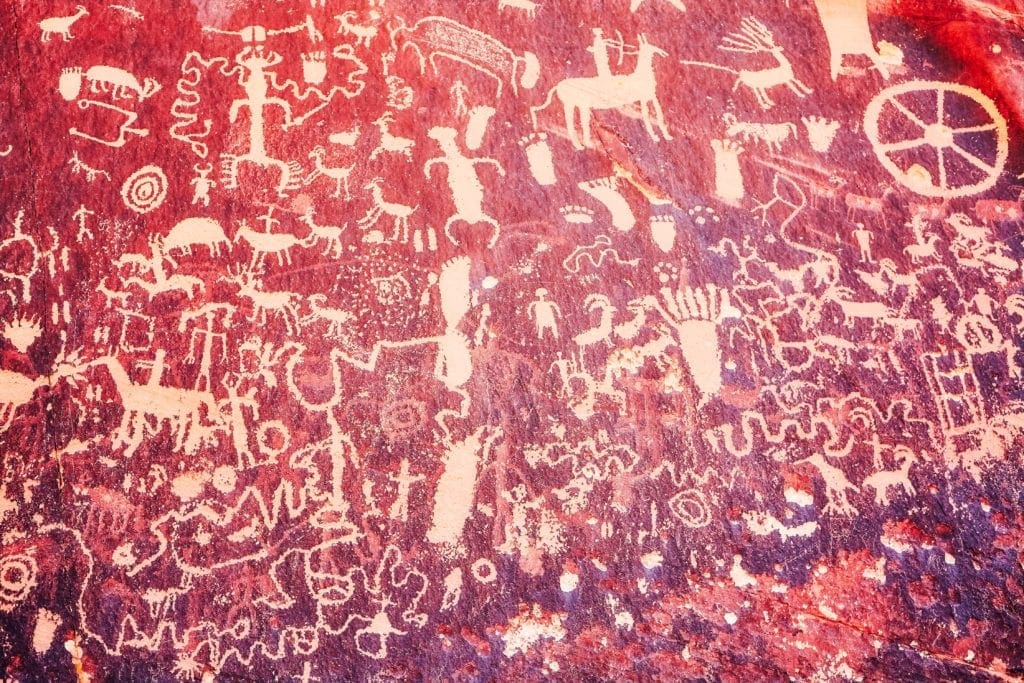
Petroglyphs on Newspaper Rock in Canyonlands National Park, Utah, USA
By around 1200 CE, there were several established villages within Canyonlands, each home to hundreds. These people left behind a wealth of artifacts showcasing the richness of their lives. The park is littered with old dwellings, such as Tower Ruin and Salt Creek Canyon. Artifacts like the Great Gallery Tool and Food Bag recovered from Canyonlands have deepened our understanding of human history. But maybe most spectacular are the works of art left behind by native peoples in the park. Some of the most impressive panels of petroglyphs ever discovered are either in, or near Canyonlands, including Newspaper Rock and those found in Horseshoe Canyon. These, and many hundreds more, decorate the silent canyon walls of the park, adding an air of mystery and depth to the landscape.
Due to its remoteness and the difficulty of the terrain, the park would be scarcely seen by European settlers until hundreds of years after these natives had gone. Major John W. Powell passed through the confluence of the Green and Colorado Rivers on his first expedition to the Grand Canyon. Later, Mormon settlers would send a contingent of pioneers to Canyonlands.
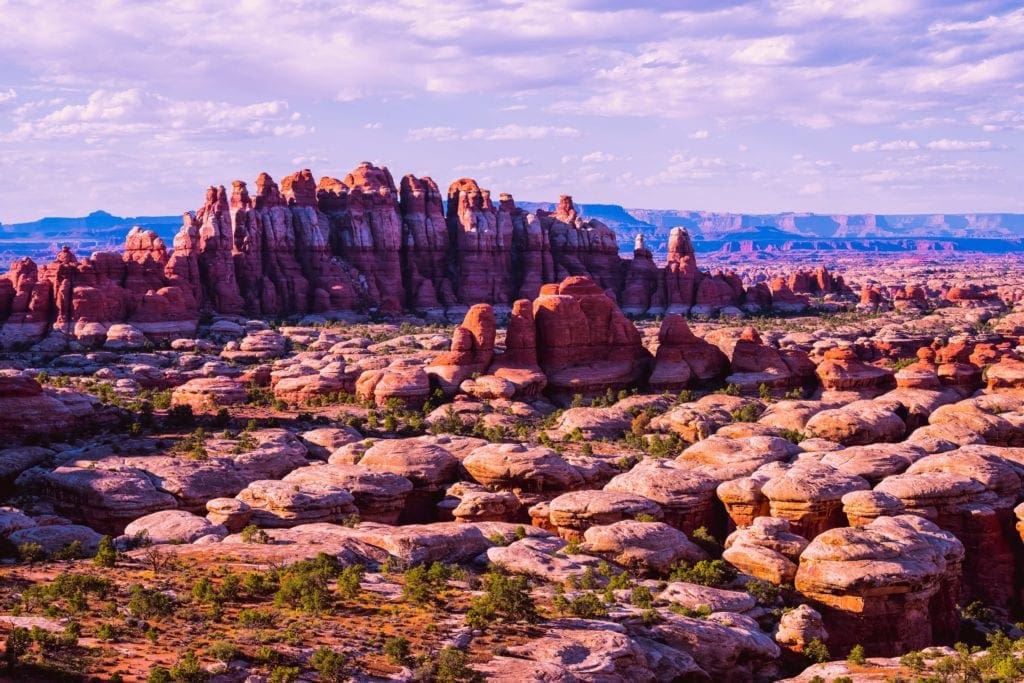
Chesler Park loop trail at The Needles, Canyonlands National Park, Utah.
In the 1950s, the area attracted the attention of Bates Wilson, then superintendent of Arches National Park. Wilson began exploring the area east of the confluence (which would later become The Needles District), and spoke up in favor of its protection. It was around this time that Edward Abbey wandered the canyons of Southern Utah, taking diligent notes that would become his famous novel Desert Solitaire. Eventually the region around the confluence of the Green and Colorado Rivers attracted enough attention within the Department of the Interior to garner support for protecting the land officially. After some lengthy debate within Congress, President Lyndon B. Johnson would name Canyonlands National Park in 1964.
Geology of The Canyonlands
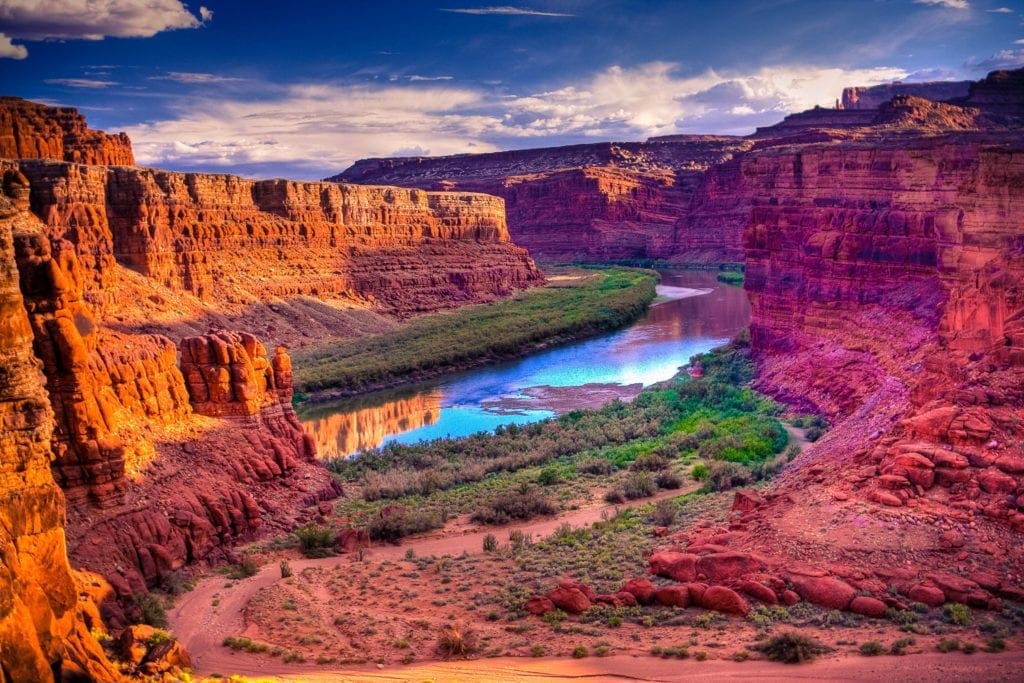
The Colorado River runs through Canyonlands National Park near Moab, Utah.
The primary features that define Canyonlands are the two mighty rivers that meet at its center: the Green and Colorado. The banks of these form the boundaries of the park’s three districts: Island in the Sky (north), The Needles (east), and The Maze (west). But geologically speaking, this is only the most recent movement in the park’s history. Many of the park’s prominent features began their journey hundreds of millions of years ago, when the area was flooded by the Permian Sea. Formations like the Elephant Canyon Formation, Cutler red beds, and most notably the White Rim Sandstone were deposited during this period. As the sea retreated, the Moenkopi and Chinle Formations which can be seen across the Southwest formed.
Over time, the region dried, giving rise to massive dunes which petrified, forming photogenic Wingate Sandstone. As rains channelized the landscape, the Kayenta Formation, one of the main arch-forming types of rock, entered the mix. Further desertification created the widespread Navajo Sandstone layer, of which many of Southern Utah’s most dramatic features are made. This includes massive anticlines like the San Rafael Swell, monoliths like the Great White Throne in Zion National Park, and hundreds, if not thousands of sandstone arches. Later, precipitation would create wide mud flats, depositing the Carmel Formation, most notable in Capitol Reef National Park, and Entrada Sandstone, the most prominent feature in Arches National Park.
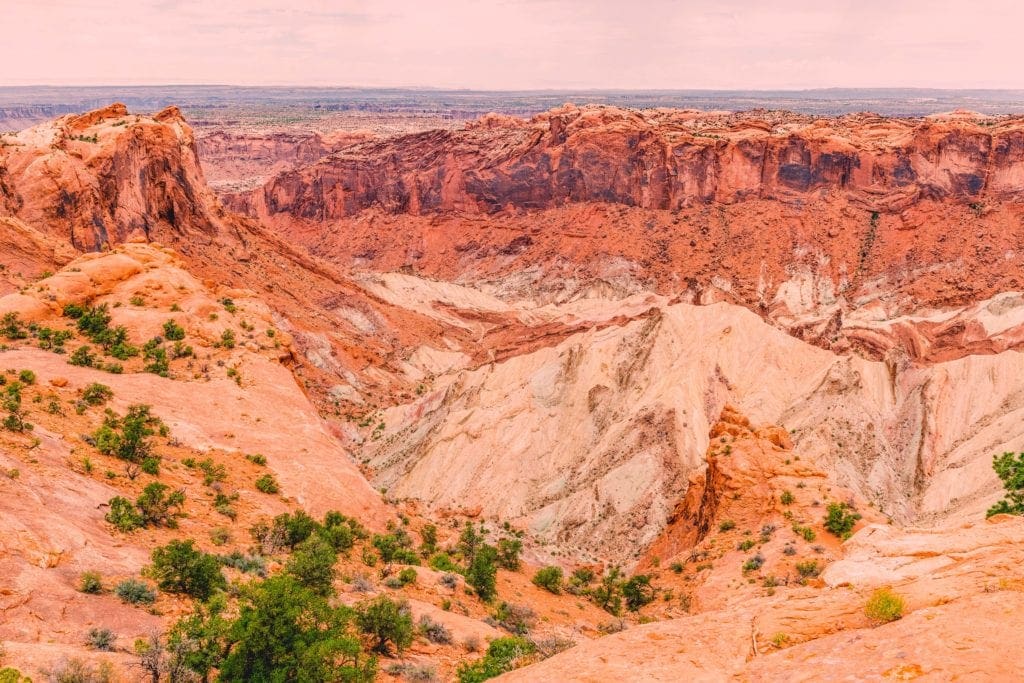
Overlook of Upheaval Dome in Canyonlands National Park, Utah
Subsequently, events like the Laramide orogeny, a massive uplift resulting in the creation of the Rocky Mountains, formed parallel faults, resulting in features called grabens. One region of Canyonlands is so dominated by faults that it is called, simply, The Grabens. Perhaps the strangest of all, however, is Upheaval Dome; a mysterious, roughly circular natural bowl that is currently thought to be the result of a meteor impact. This incredibly complex geological history creates a variety of features that runs the full spectrum of the desert. You will find huge cliffs banded in multicolored stone, free-standing towers that shoot skyward like spears, panoramic arches, and labyrinthine canyons around every corner in Canyonlands. And as the rivers deepen the park’s many canyons, this ever-changing landscape grows only more and more interesting.
Wildlife and Ecology
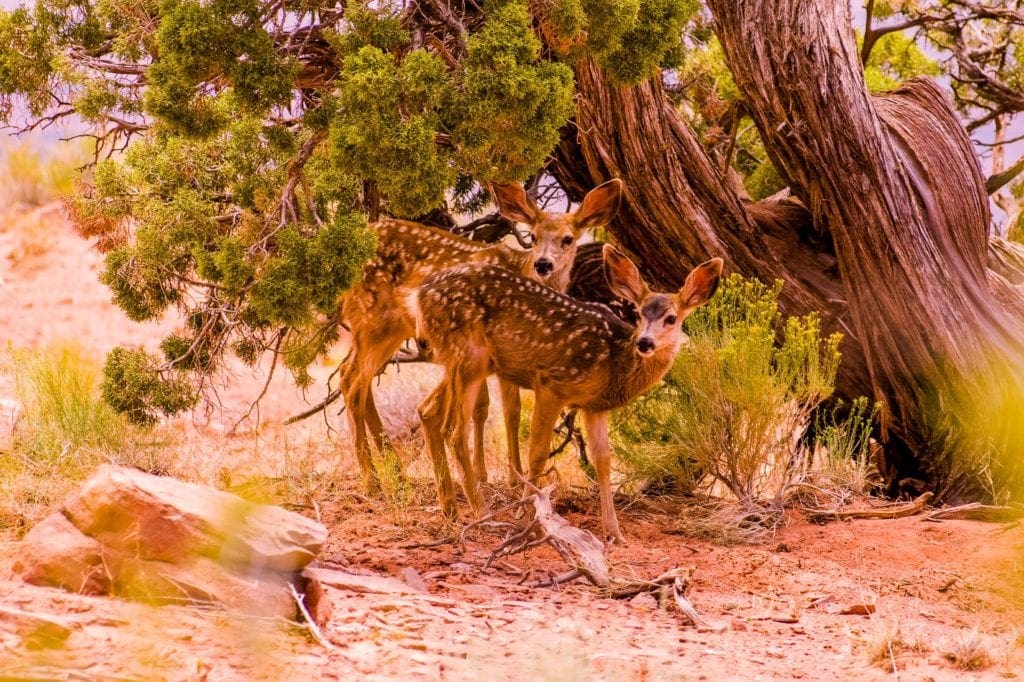
Mule Deer in Canyonlands National Park, Utah.
The ecology of the Colorado plateau is fascinating, and surprisingly diverse. In some places, birds and reptiles are the dominant animal species, thriving in the extreme heat with minimal water. At higher elevations, where the winters are colder and perennial water sources are more common, small mammals can eke out a living. But where water is readily available year-round, large mammals will do well for themselves.
Different parts of Canyonlands fit into each of these categories. On the whole, small mammals, reptiles, and birds do the best, but there are still large mammals which either migrate to, or spend all year in the park. This list contains everything from mule deer and cougars to bighorn sheep and black bears. Smaller mammals like beavers, kangaroo rats, mice, and rabbits are common throughout the park.
The highest number of species in a group goes to the birds, of which 273 species can be found in Canyonlands. Depending on the time of year, you may see great blue herons and Cooper’s hawks looking for prey, or hear the songs of canyon wrens and blue grosbeaks echoing across canyon walls. Many of the birds that frequent Canyonlands are on the smaller side, like western meadowlarks, pinyon and scrub jays, and spotted towhees.
The picture of a desolate desert landscape wouldn’t be complete without reptiles. There are eleven species of lizards that are commonly seen throughout the park, as well as eight snakes. This includes the prairie rattler and midget faded rattlesnake. But what you might not expect are the six species of amphibians that live in the park’s waterways, like the northern leopard frog, Great Basin spadefoot toad, and tiger salamander.
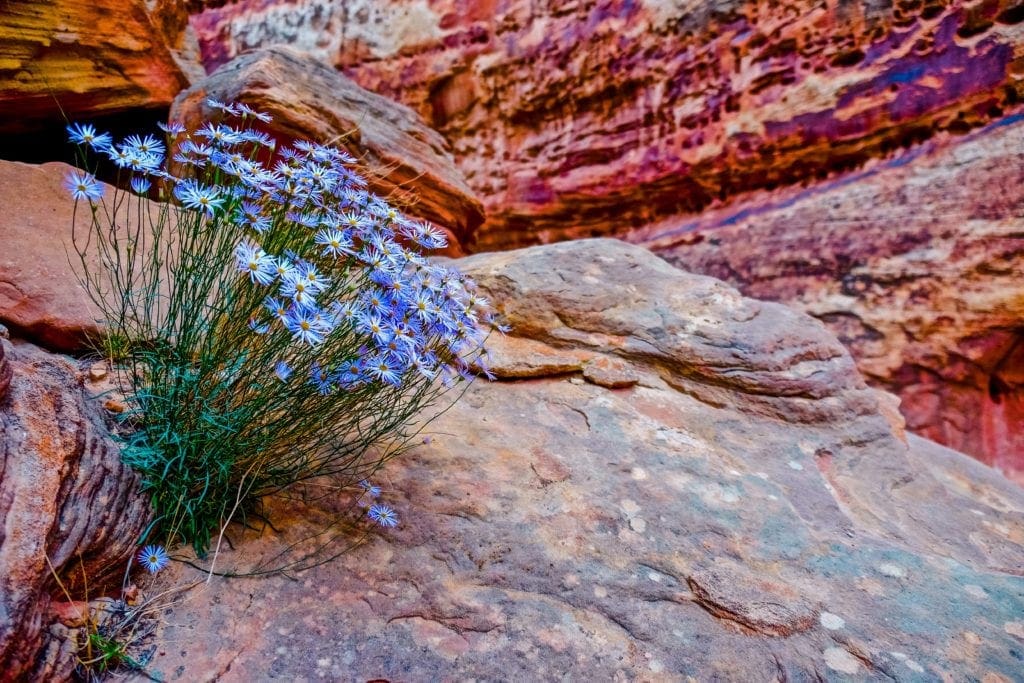
Blue Aster
Supporting this network of animal life is a hearty community of plants. This includes cacti, mosses, grasses, wildflowers, shrubs, and trees. You can expect to find pinyon pine and juniper dotting cliff sides and sandbars, but may be surprised to see broadleaf cottonwood trees. Depending on the presence of water, shade, or the type of soil, you will see completely different plant ecosystems tucked away in the nooks and crannies of the park’s side canyons. Each of these ecosystems is held together by one element that gives life to everything else in the desert: cryptobiotic soil. This special type of soil forms thick black crusts, which are made up of microscopic algae, fungi, and microorganisms. They are incredibly fragile and can be destroyed with a single footstep, which is why all parks in Southern Utah have such strict rules regarding Leave No Trace ethics.
Main Attractions
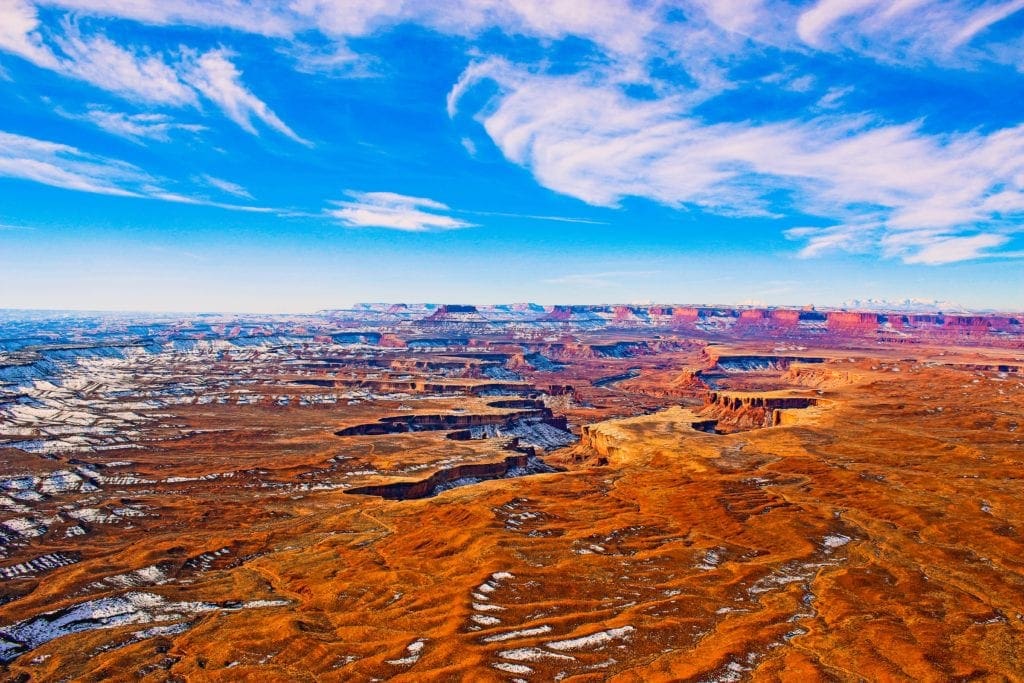
Islands In The Sky in Canyonlands National Park, Utah.
Though Canyonlands is chock full of opportunities for ambitious adventurers to get well off the paved-and-beaten path, there are quite a few panoramic views that you can reach easily. Most of these are located in Island in the Sky. This district draws three quarters of the park’s visitors due primarily to its ease of access. With a day in Island in the Sky, you could easily hike to Mesa Arch, Upheaval Dome, and see Grand View Point. You could hike to the White Rim Overlook, which circles the entire district, or clamber over Whale Rock, a conspicuous fin of orange sandstone. All in all, not a bad day. But if you have more time to spare, it’s a good idea to dig into the area by way of your chosen form of recreation.
4×4/Offroading
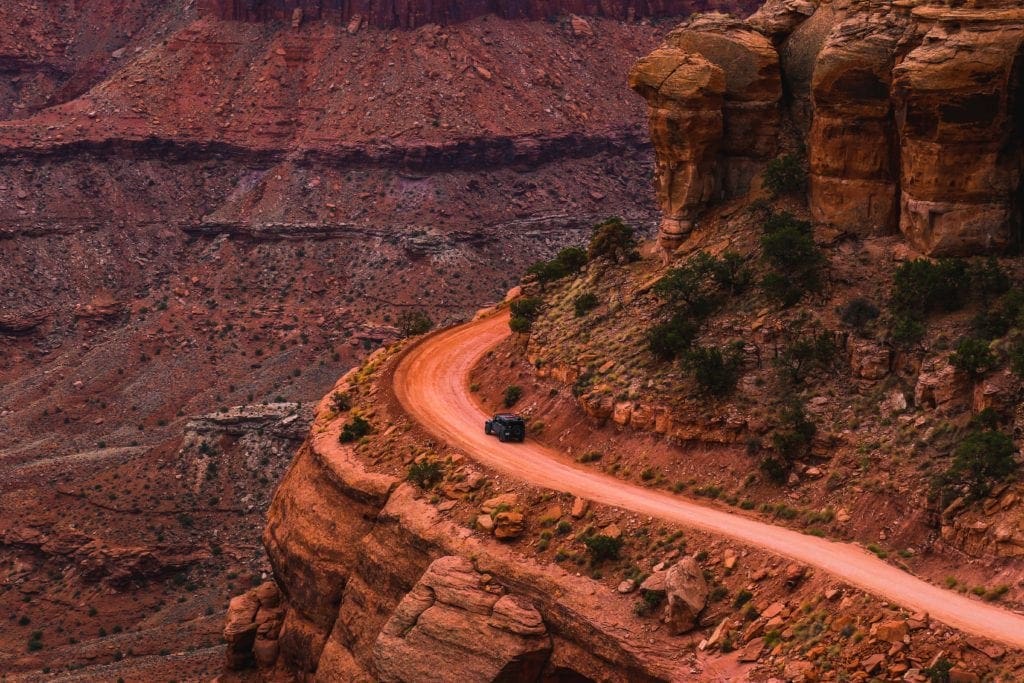
A jeep driving along Shafer Canyon Road in Canyonlands National Park, Utah.
Canyonlands stands out among national parks as being a hub for off road driving. Each of the districts of Canyonlands has its own draw for technical offroading. In Island in the Sky, The White Rim Road is a formidable objective for experienced drivers looking to take on a multi-day trail. The road transitions rapidly from dirt to gravel to rock and back, and is rated overall as moderate. The challenge for most comes from the remoteness of the trail.
In The Needles, 4WD is almost required to see the major sights. Paul Bunyan’s Potty, Tower Ruin, Castle Arch, and Fortress Arch are all accessible by 4WD vehicles only. Done as an out-and-back, this makes for a great day of offroading. But if difficult trails are what you came for, Elephant Hill should be number one on your list. Beyond Elephant Hill is Devils Lane trail, which can be taken to the Confluence Overlook and Chesler Park. This area can be explored over several days, camping at Devils Kitchen or New Bates Wilson Campgrounds.
But all these pale in comparison to The Maze, the shining gem of the park. To 4×4 enthusiasts, The Maze is the holy grail. It’s the ultimate destination for hardcore motorheads, requiring total self-reliance, a complete understanding of your rig, and expert level driving skills. If you break down, you need to be prepared to self rescue or wait days on end for help. Navigation alone is a leviathan undertaking, and then there’s the driving itself. The Maze is the gold standard for prolonged, technical obstacles requiring both a capable rig and the skills to use it. If you dare, plot your objectives long in advance and work with park staff to plan and permit your trip. If you can take on The Maze, you can take on anything.
Hiking
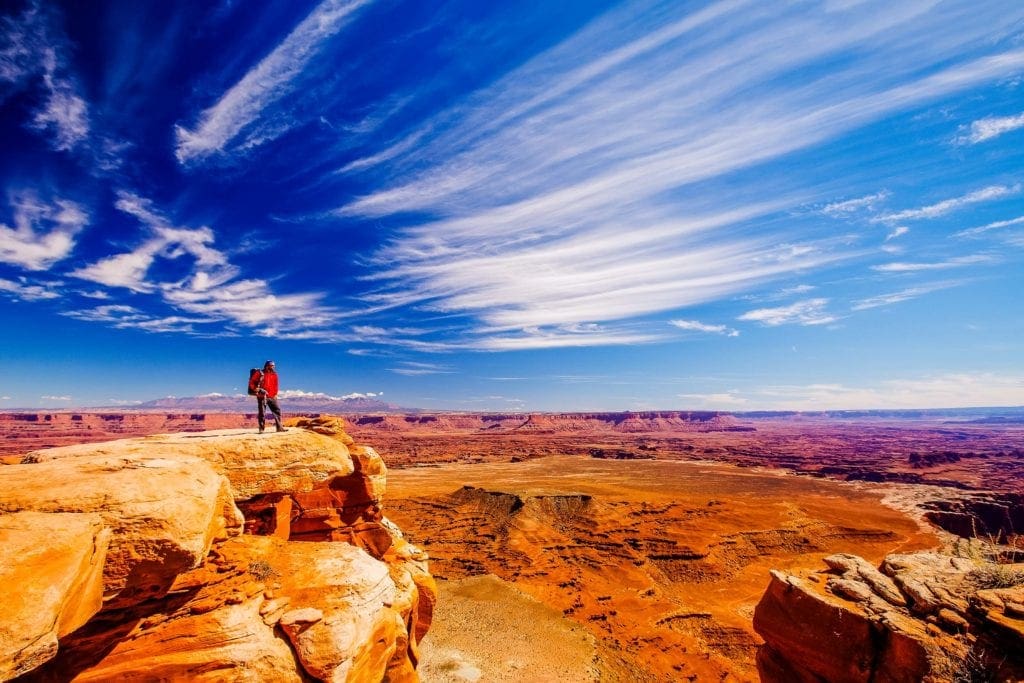
Hiker in Canyonlands National Park in Utah.
Hiking is the main fare for visitors to explore Canyonlands. Depending where you are, there will always be something striking to hike to nearby. In Island in the Sky, hikes like the Syncline Loop, which traverses Upheaval Dome, and Murphy Trail are top notch options. In The Needles, a short jaunt to Cave Spring will give you a window into the park’s history. With some more effort, you can see Chesler Park or Druid Arch, two of the strangest features in Canyonlands. The Maze requires more than just a hike to explore, but if you find yourself there, be sure to check out Horseshoe Canyon, which is known for having some of the greatest galleries of ancient art anywhere.
Camping
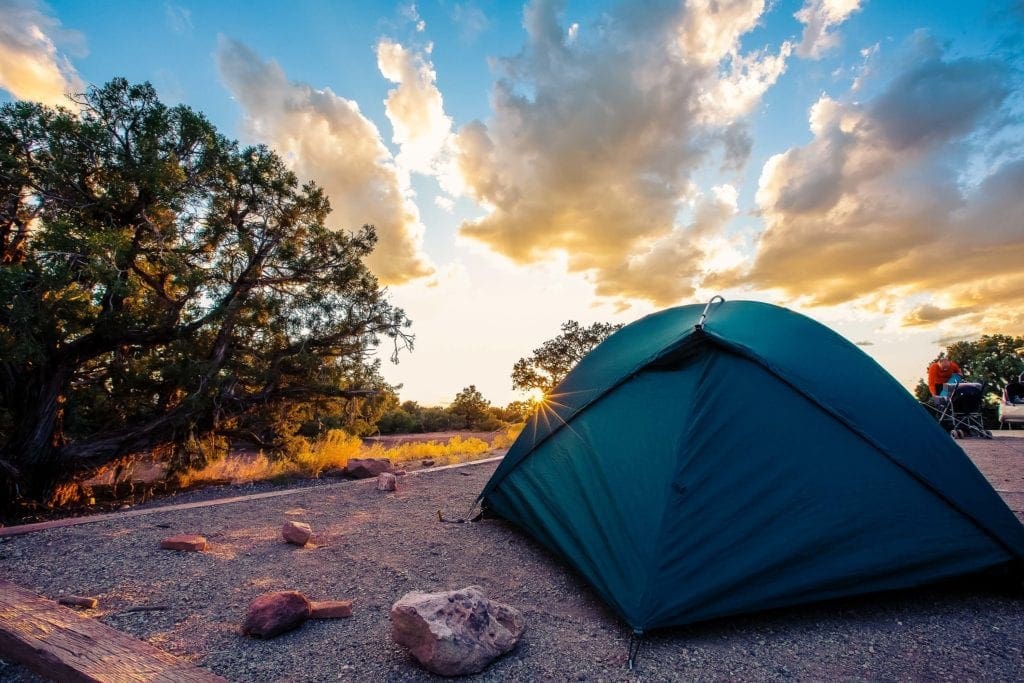
Camping in Canyonlands National Park, Utah
Canyonlands has a good spread of opportunities for camping. In Island in the Sky, you can pitch your tent at Willow Flat, which has twelve sites and is open year-round. It provides access to the Green River Overlook and has twelve sites, which go for $15 per night.
On the east side of the confluence, The Needles Campground offers 26 sites, which go for $20 per night and are open all year. There are tons of great hiking trails right around the corner from The Needles Campground, as well as Elephant Rock, a popular 4×4 trail. Just outside the park boundary of The Needles is the Needles Outpost, a privately-owned campground with more accommodations if those in the park are full. Tent sites are just $25, making it a solid backup option to camping in the park.
Depending on how you plan on recreating, there are lots of backcountry campsites throughout the park. These require some permitting ahead of time, but if you plan on going way, way out, definitely look into it. Camping in the Canyonlands backcountry is an unforgettable experience.
Backpacking
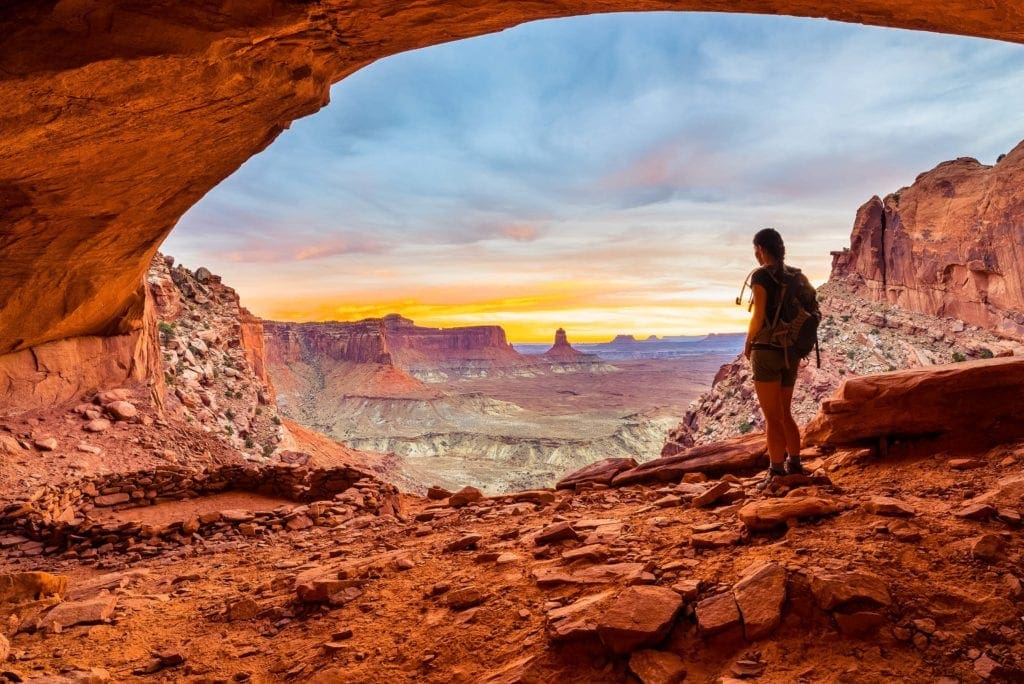
Backpacker looking at a beautiful sunset from inside of the False Kiva in Canyonlands National Park Moab, Utah.
The possibilities for backpacking through Canyonlands are almost endless. Particularly in The Needles District, the network of backcountry trails seems almost designed for fantastic multi-day trips. Working with the trails, approved backcountry camping areas, and park officials, there is a plethora of objectives you could take on. Chesler Park, Devils Kitchen, Big Spring Canyon, Peekaboo Spring, Angel Arch, Cathedral Butte, and the Confluence Overlook are all possibilities that could be done alone or together.
But the other districts of the park are also full of viable options. Lathrop Canyon, which can be taken to the Colorado River, is a great two night out-and-back trail in Island in the Sky. Like with most things, backpacking The Maze can be a bit of an ordeal, though rewarding. Due to the strenuousness and complexity of the terrain, backpackers should have experience climbing and canyoneering, as well as excellent orienteering skills. Backpacking The Maze should be organized with the help of park officials and not be taken lightly. The 4×4 driving required to access trailheads alone is enough to send any greenhorn running for the hills. But if you have the skills, the tools, and the guts, backpacking The Maze is an adventure you’ll never forget.
Climbing
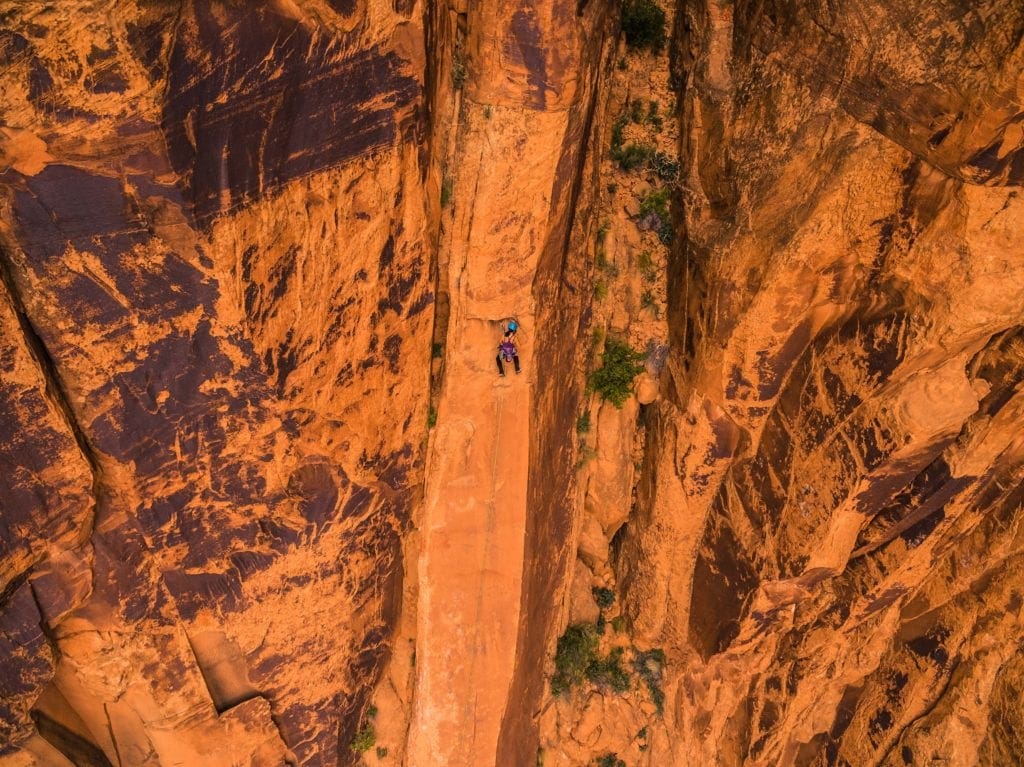
Rock climber in Canyonlands National Park near Moab, Utah.
As you might expect from any place defined by having huge stone walls, there is some spectacular climbing in Canyonlands. Most of the climbing in the park is centered around The White Rim of the Island in the Sky District. This whitish cliff band circles the long mesa between the Green and Colorado Rivers, north of the confluence. The primary fare here is about what you would expect for climbing in the Moab area: outstandingly beautiful, gutbustingly hard trad climbing. Classics like Primrose Dihedrals, In Search of Suds, and The Regular Route (FA by the famous Kor-Ingalls duo of Castleton Tower fame) will push you to the limit. These are some of the most intense big wall climbs that red rock country has to offer.
River Rafting
Canyonlands has a myriad of options for everything from flatwater rafting to Class V rapids to packrafting. The park serves as the main access for Cataract Canyon, one of the most famously difficult and intense whitewater rapids in the United States. There are a slew of options you can permit for, including day trips, overnights, and backpacking trips to the river to raft sections. As with most involved endeavors in the park, check with park officials to figure out the best way to make your plans work.
Bike Touring and Mountain Biking
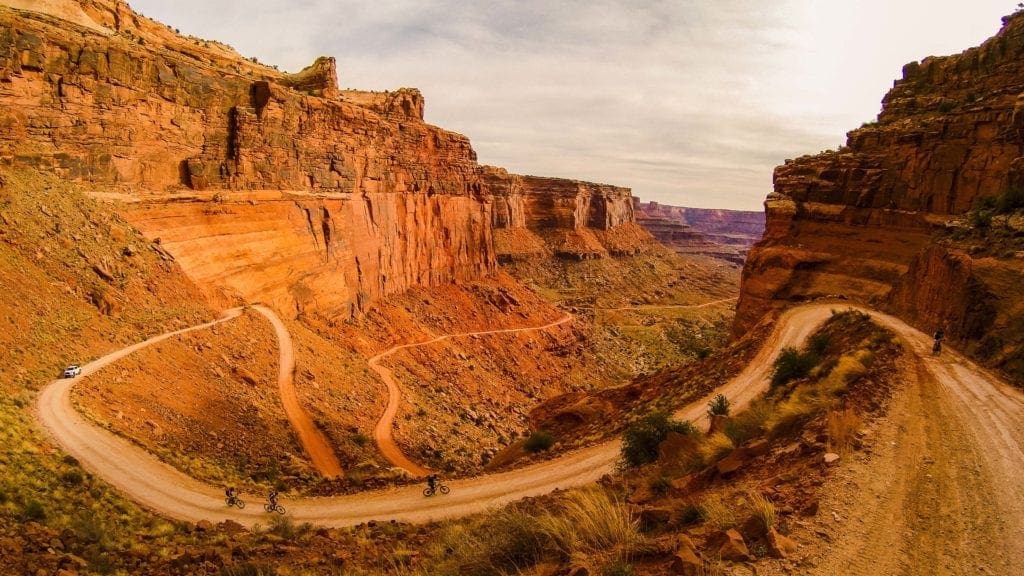
Bike Touring and Mountain Biking in Canyonlands National Park, Utah.
As a happy side effect of having so many 4×4 trails in the park, there are lots of options for mountain biking and bike touring through Canyonlands. In fact, due to how common bike-friendly trails are in Canyonlands, seeing the park by bike might be the best way to do it.
If you’re after a multi-day loop, go for the White Rim Road, a 100-mile stretch that can be done in a few days, depending on your fitness. As a bike tour, this is one of the most scenic routes in Southern Utah. The shorter trails through The Needles can be biked as well. Having more access to backcountry campsites allows you to have a basecamp, taking day trips to the incredible sights in the district. The Maze can also be biked, with similar rules to 4×4 travel. Be prepared for the same level of isolation and self-reliance that would be required to take on The Maze in a 4WD vehicle.
The Weird, The Wonderful, and The Magical
Canyonlands is one of the last truly untamed corners of the United States. It’s a place where you could lose yourself, or quite literally get lost. It calls to people who crave the independence and freedom of a landscape that rolls over the horizon, around the next bend, away and out of sight. Where the only thing stopping you from seeing it all is your own ability. It’s a challenge that speaks to the adventurer in us all. The gauntlet is thrown, now go and see for yourself.
Skyblue Featured Video: Exploring the Canyonlands in Moab on the UBCO 2X2 Special Edition.
Exploring the stunning scenery of the Canyonlands in Moab on UBCO’s 2X2 Special Edition Electric Motorbike. Ready for on-road or off-road adventures, this bike is perfect for everyday journeys or your daily commute.
When a travel emergency arises, traditional travel insurance may not come to your aid, and a medical evacuation can cost up to $300,000.
The cost when you have a Global Rescue membership? $0. That’s why when the unexpected happens, you want the leader in rescue, evacuation and medical advisory behind you. You want Global Rescue.




